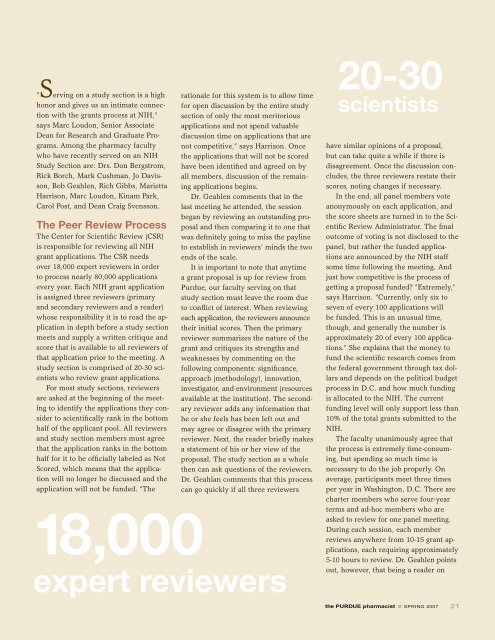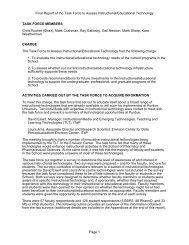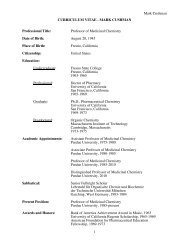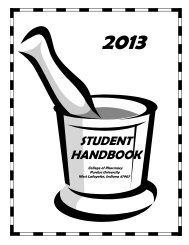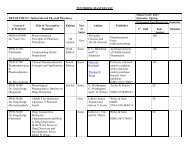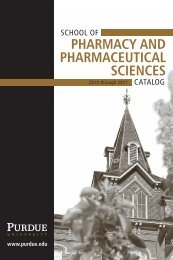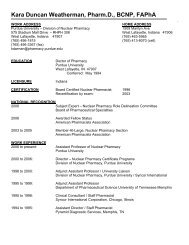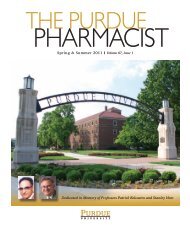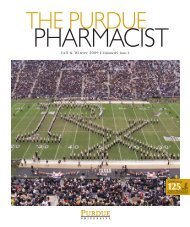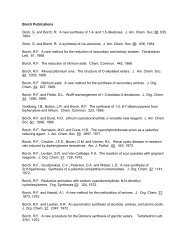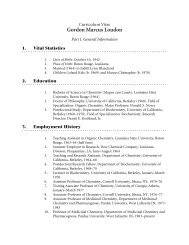Spring 2007 - Purdue College of Pharmacy - Purdue University
Spring 2007 - Purdue College of Pharmacy - Purdue University
Spring 2007 - Purdue College of Pharmacy - Purdue University
Create successful ePaper yourself
Turn your PDF publications into a flip-book with our unique Google optimized e-Paper software.
“Serving on a study section is a high<br />
honor and gives us an intimate connection<br />
with the grants process at NIH,”<br />
says Marc Loudon, Senior Associate<br />
Dean for Research and Graduate Programs.<br />
Among the pharmacy faculty<br />
who have recently served on an NIH<br />
Study Section are: Drs. Don Bergstrom,<br />
Rick Borch, Mark Cushman, Jo Davisson,<br />
Bob Geahlen, Rich Gibbs, Marietta<br />
Harrison, Marc Loudon, Kinam Park,<br />
Carol Post, and Dean Craig Svensson.<br />
The Peer Review Process<br />
The Center for Scientific Review (CSR)<br />
is responsible for reviewing all NIH<br />
grant applications. The CSR needs<br />
over 18,000 expert reviewers in order<br />
to process nearly 80,000 applications<br />
every year. Each NIH grant application<br />
is assigned three reviewers (primary<br />
and secondary reviewers and a reader)<br />
whose responsibility it is to read the application<br />
in depth before a study section<br />
meets and supply a written critique and<br />
score that is available to all reviewers <strong>of</strong><br />
that application prior to the meeting. A<br />
study section is comprised <strong>of</strong> 20-30 scientists<br />
who review grant applications.<br />
For most study sections, reviewers<br />
are asked at the beginning <strong>of</strong> the meeting<br />
to identify the applications they consider<br />
to scientifically rank in the bottom<br />
half <strong>of</strong> the applicant pool. All reviewers<br />
and study section members must agree<br />
that the application ranks in the bottom<br />
half for it to be <strong>of</strong>ficially labeled as Not<br />
Scored, which means that the application<br />
will no longer be discussed and the<br />
application will not be funded. “The<br />
rationale for this system is to allow time<br />
for open discussion by the entire study<br />
section <strong>of</strong> only the most meritorious<br />
applications and not spend valuable<br />
discussion time on applications that are<br />
not competitive,” says Harrison. Once<br />
the applications that will not be scored<br />
have been identified and agreed on by<br />
all members, discussion <strong>of</strong> the remaining<br />
applications begins.<br />
Dr. Geahlen comments that in the<br />
last meeting he attended, the session<br />
began by reviewing an outstanding proposal<br />
and then comparing it to one that<br />
was definitely going to miss the payline<br />
to establish in reviewers’ minds the two<br />
ends <strong>of</strong> the scale.<br />
It is important to note that anytime<br />
a grant proposal is up for review from<br />
<strong>Purdue</strong>, our faculty serving on that<br />
study section must leave the room due<br />
to conflict <strong>of</strong> interest. When reviewing<br />
each application, the reviewers announce<br />
their initial scores. Then the primary<br />
reviewer summarizes the nature <strong>of</strong> the<br />
grant and critiques its strengths and<br />
weaknesses by commenting on the<br />
following components: significance,<br />
approach (methodology), innovation,<br />
investigator, and environment (resources<br />
available at the institution). The secondary<br />
reviewer adds any information that<br />
he or she feels has been left out and<br />
may agree or disagree with the primary<br />
reviewer. Next, the reader briefly makes<br />
a statement <strong>of</strong> his or her view <strong>of</strong> the<br />
proposal. The study section as a whole<br />
then can ask questions <strong>of</strong> the reviewers.<br />
Dr. Geahlan comments that this process<br />
can go quickly if all three reviewers<br />
18,000<br />
expert reviewers<br />
20-30<br />
scientists<br />
have similar opinions <strong>of</strong> a proposal,<br />
but can take quite a while if there is<br />
disagreement. Once the discussion concludes,<br />
the three reviewers restate their<br />
scores, noting changes if necessary.<br />
In the end, all panel members vote<br />
anonymously on each application, and<br />
the score sheets are turned in to the Scientific<br />
Review Administrator. The final<br />
outcome <strong>of</strong> voting is not disclosed to the<br />
panel, but rather the funded applications<br />
are announced by the NIH staff<br />
some time following the meeting. And<br />
just how competitive is the process <strong>of</strong><br />
getting a proposal funded? “Extremely,”<br />
says Harrison. “Currently, only six to<br />
seven <strong>of</strong> every 100 applications will<br />
be funded. This is an unusual time,<br />
though, and generally the number is<br />
approximately 20 <strong>of</strong> every 100 applications.”<br />
She explains that the money to<br />
fund the scientific research comes from<br />
the federal government through tax dollars<br />
and depends on the political budget<br />
process in D.C. and how much funding<br />
is allocated to the NIH. The current<br />
funding level will only support less than<br />
10% <strong>of</strong> the total grants submitted to the<br />
NIH.<br />
The faculty unanimously agree that<br />
the process is extremely time-consuming,<br />
but spending so much time is<br />
necessary to do the job properly. On<br />
average, participants meet three times<br />
per year in Washington, D.C. There are<br />
charter members who serve four-year<br />
terms and ad-hoc members who are<br />
asked to review for one panel meeting.<br />
During each session, each member<br />
reviews anywhere from 10-15 grant applications,<br />
each requiring approximately<br />
5-10 hours to review. Dr. Geahlen points<br />
out, however, that being a reader on<br />
the PURDUE pharmacist n SPRING <strong>2007</strong><br />
21 3


